On thursday morning 4.5.2006 we headed for Helsinki airport. AirBerlin plane was in the air 14:20 having a stopover in Berlin/Tegel. We had plenty of time there but – suddenly we were announced in the speakers and told to hurry to the boarding gate. So we did but as we got there there was a long queue which wasn´t moving anywhere. It actually turned out that our flight to Rome was a bit late… It´s a mystery why we were announced – must have been a mistake. Anyway, we landed successfully on Rome Fiumicino 20:05. It was hottish as the Info point woman also said with sweat drops on her forehead: “Caldo!” We managed to find Europcar office on the 3rd floor, did some paperwork and paid the guarantee with Visa Card. Then we had to push our luggage trolleys to the next floor in another wing of the airport – to have the car which turned out to be a Lancia Musa. Off we went, then. At that time we didn´t have a navigator – they were a novelty and not cheap either. Don´t know if it would have been any better with one but now only with a paper map we drove past the right exit and had to drive back to the airport and try again. And – again we missed it. It was already dark which didn´t help. We ended up near the centre of Rome beside a park and asked for help. We were supposed to sleep the night in a Mobil Home at Seven Hills Holiday Village in Via Flaminia (the old Roman highway to north). After a couple of attempts we got help from a guy who offered to drive before us some kilometres to guide us to a point where we could go on by ourselves. He didn´t want any other reward but that we´ll send him a postcard when we get home. Which we also did.
The gate of our holiday village was already closed as we reached it. We phoned to the given number and we´re told to drive some hundreds of meters to another gate. There we found that the “Supermerket” (more like a big kiosk) was not open anymore contrary to the promises on Internet. The gatekeeper saved us from starving by fetching us a bottle of table wine, some bread and prosciutto from the kitchen for 20 euros. Our “Mobile Home De Luxe” was not very luxorious but gave us the sleeping place for night. Without heating it was quite cold first but soon we had it warmer. In the morning of 5.5. the sun was shining and respectively life smiling again. Still a bit tired from previous day we took a little walk watching the beautiful plantings and pelicans making their funny sounds in the garden, had a simple breakfast and started to Florence 285 km north.
You may ask why we didn´t take photos of any bridges in Rome. There would have been for example the Bridge of the Angels/ Ponte Sant´Angelo with its many statues. Well that was something we had to leave out of our schedule (see the About section of this blog), wise or not. We decided to visit Rome later some year…
Partly frightened by the last evening´s misnavigations in the motorway we took a nice but (as we later noticed) slow route. We stopped to shoot some photos of the first nice bridge on our journey ca. 40 km from Rome, 20 km before Viterbo, in a small commune called Sutri. This simple wooden truss bridge is rather small and newish but you don´t see much of this type nowadays. It is also very similar to a somewhat bigger, now bygone bridge in our home town of that time which we had seen in an old picture. The bridge was almost at the foot of Cathedral Santa Maria Assunta:
The bridge was almost at the foot of Cathedral Santa Maria Assunta:

As we reached Florence we had to hurry a bit to be able to even try to arrive at a reason-able time in Cesena where we were supposed to overnight. We managed to find a street-side parking place by the Piazza di Porta Romana and started walking towards the famous Ponte Vecchio (Old Bridge) half a kilometer away. Before seeing it we had to bite some panninis and find a toilet. It was weekend and there were a couple of other people admiring the tourist attractions, too… On the narrow allies one had to look out for cars and motorbikes, too. But that was before mayor Matteo Renzi declared the historical World Heritage center a car free zone in October 2009. Before the decision thousands of buses rumbled past Duomo at a distance of some meters thus shaking its marble walls and the famous dome planned and executed by Filippo Brunelleschi 1420-36.
Here you see the south end of Corridoio Vasari, Vasari Corridor. It´s an elevated passage-way built in 1565 ordered by the most famous of the Medici dukes, Cosimo I to the design of Giorgio Vasari, architect and art historian. The corridor goes from Palazzo Pitti over Ponte Vecchio (the Old Bridge) to turn on the right after the bridge and going on along the riverside to Palazzo Vecchio. Ponte Vecchio starts immediately after the tower in the photo, Torre Mannelli. It is the only survivor of the original four towers defending the bridge in all its corners. The Mannelli family refused to let the tower be altered or demolished because of the Corridoio and so the Vasari Corridor had to be narrowed and swerved around the tower on brackets – which makes a very fine addition to the whole! 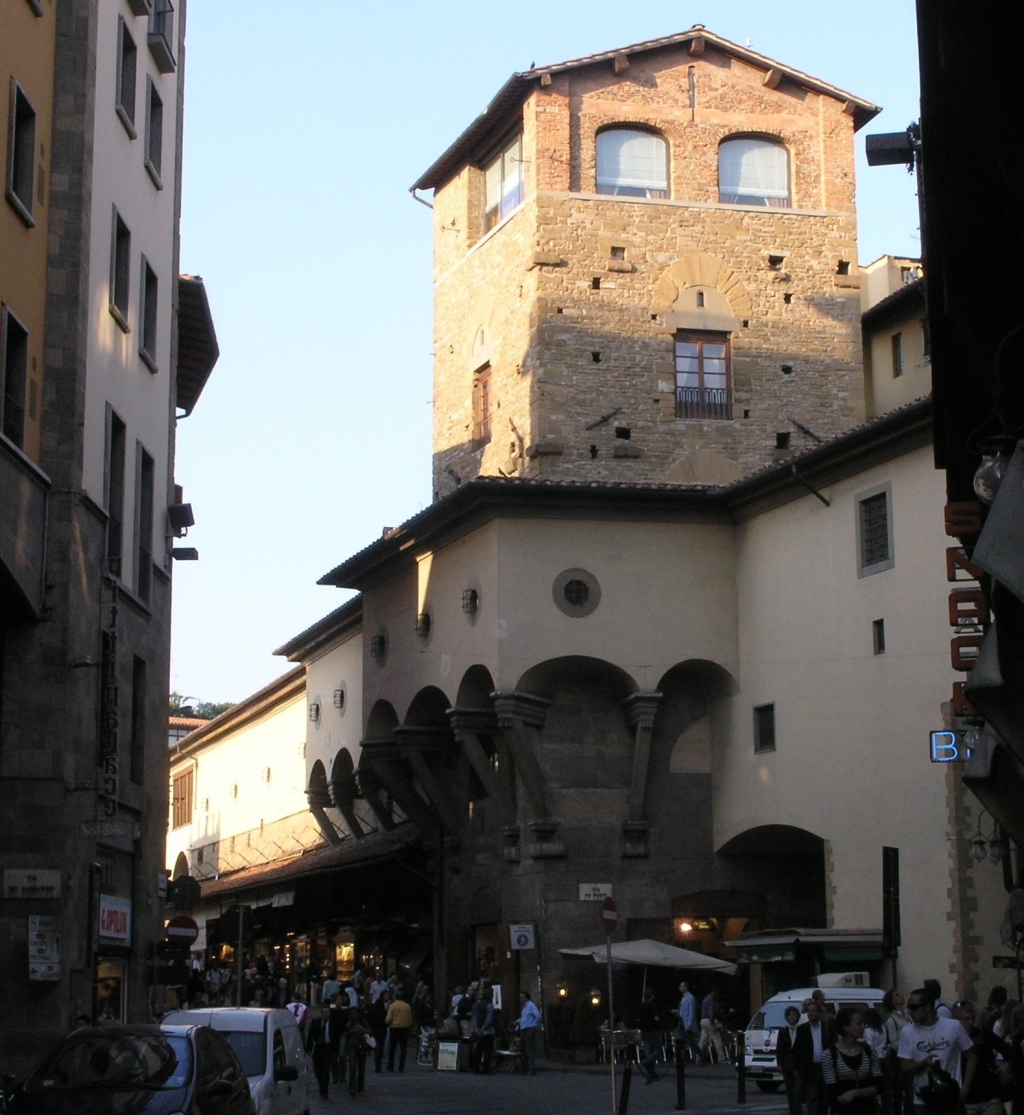
Vasari Corridor is today the home of the self portrait collection of the nearby Uffizi Gallery, one of the most visited art galleries in the world. Originally it was a way for the nobility to be able to walk between their palaces safely without being seen by the common people down on the bridge. It also gave them some distance from the noisy and stinky business of the butchers, fishmongers and tanners – which were at last driven away 1593 by the order of Ferdinando dé Medici. Since that only goldsmiths and jewelers (and today also art dealers and souvenier shops) were allowed to live and work in the shops, 44 altogether, that give the bridge its unique facade. The protruding backshops were built in 17th century when the shops turned from public to private property. There had been craftsmen´s workshops already on the previous bridge. The colourful backshops gave the final touch the bridge built ca. 250 years earlier.
The panorama windows of Vasari Corridor in the middle of the bridge were assembled in 1939 ordered by Mussolini before the meeting with Hitler behind the windows. Hitler, known as an art lover, is told to have been so impressed of the view and the bridge that he commanded Ponte Vecchio to be saved of exploding in 1944 as German troups withdrew before the Allied, as the only bridge of the four crossing river Arno. Anyway the official honour of that is given to Gerhard Wolff, German consul in Florence.
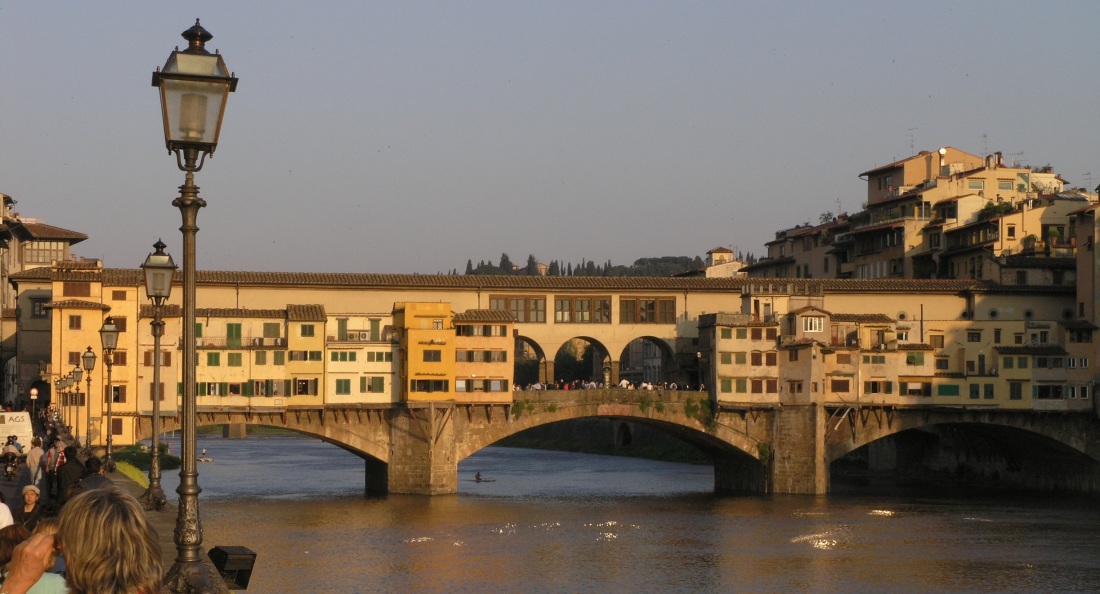
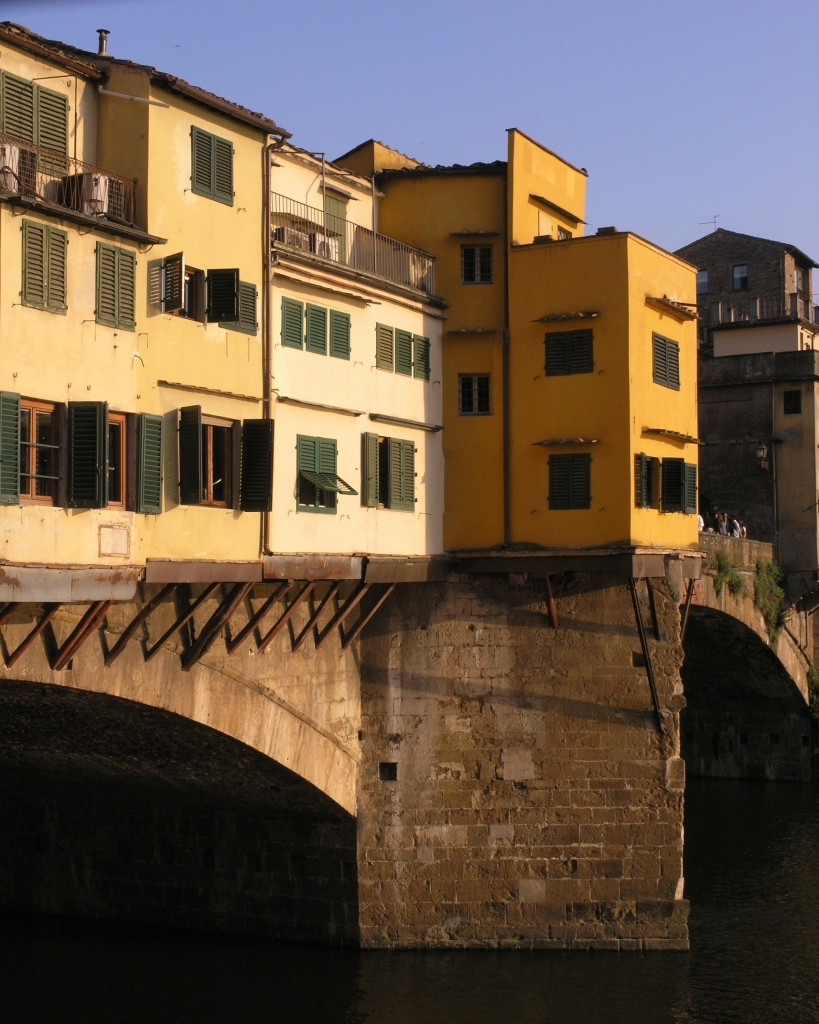
There has probably been a bridge already in Roman times here where Via Cassia cross-ed the river. The first written mention is from year 996. That bridge had cut-waters of stone and a wooden superstucture. It was destroyed by a flood in 1117 and replaced by a stone bridge with 5 openings. But again – it was damaged in floods of 1222 and 1322 – and swept away in 1333 save two of the central piers. Before starting the building process of today´s bridge the city let build high walls along the riverbed to protect the lower parts of the area to be damaged in later floodings. When the walls were finished they could begin to build the bridge which took 10 years ending 1345.
There´s some mysticism about who was in charge of the design of the bridge. A long time it was believed to be Taddeo Gaddi (1290-1366), assistant of painter and architect Giotto and after Giotto the foremost artist in the city. Giorgio Vasari recorded Gaddi as the designer – about 200 years after the completion of the bridge… but Giovanni Villani, florentian banker and chronicler (c.1280-1348) attested in his Nuova Cronica that Gaddi only worked as the supervisor of masonry and assistant of Neri di Fioravante who was the real master of the bridge project. There aren´t too many mentions about di Fioravante in history. Still, we know surely that born in Pistoia, 30 km northwest of Florence, as son to Fioravanti di Fioravante, he was active in Florence as an appreciated architect and mason 1340-84 (or 1374). One of his major works was the converting of a former grain market hall to Church of Orsanmichele which he did co-operating with two colleagues, Francesco Talenti and Benci di Cione. Giorgio Vasari also attributed to him the enlargement of Bargello Palace, begun in 1340. He´s known also to have made a proposition to the design of the Duomo and a study for its cupola, 1367. Pistoia itself is a city of several masterpieces of roman and renaissance architecture so it was a good place for an architect to grow up and draw influences. We don´t know anything about his activities in his hometown but – perhaps he was attending as apprentice the building work of the Fortress of St. Barnabas which the city state of Florence had built in Pistoia, being finished 1331. With that experience he may well have moved with Florentian builders to Florence to start a career as a professional there.
Ponte Vecchio is worldfamous for its pictoresque look but it´s not commonly known that it was also technically advanced in its time. It was the first bridge in Europe with low segmental arches – an outstanding engineering achievement of the European Middle Ages. It has three arches, the middle one being somewhat longer – 30 m – than the others. Requiring fewer piers in the stream than the Roman semicircular-arch design applied so far, the segmental arch offered less obstruction to navigation and freer passage to flood-waters. The span-to-rise ratio of Ponte Vecchio is about 6,5:1 as the ratio is 2:1 in a semicircular arch – a considerable difference. The Chinese bridge master Li Chun had reached quite near already 750 years earlier with his famous An-Ji Bridge: 5,3:1. But then the Chinese bridge engineering was also generally hundreds of years ahead of the West-ern one. The advantages of the shallow segmental arch were quickly understood in the regions nearby. The first successor, Ponte di Castelvecchio with its longest span being 48,7 m was built already 1354-56 in Verona by Guglielmo Bevilacqua.
A small amendment inspired by The Happy Pontist´s (blogger himself, too) comment: also the Romans occasionally built segment arch bridges although they weren´t as shallow as Ponte Vecchio´s. He mentioned Puente de Alconétar in Spain, built already in early 2nd century, span-to-rise 4-5:1,and Kildwick Bridge, North Yorkshire, built 1305-13. The latter´s ratio seems to be ca. 3:1 (my estimation based on a photo in the net).
The word bankrupt is told to have its origins here in Florence but they may as well be somewhere else in Italy, e.g. the republic of Genoa: The word bankruptcy is derived from banca rotta, meaning “broken bench (bank)”. In medieval Italy, money lenders worked from tables, or benches. They sat on these specially designed furniture pieces waiting for customers. In latin the word “banca” means bench. When a money dealer ran out of money, his table (or bench) was broken (rotta) – literally with sword or just as a figure of speech, and he could no longer deal money. This word is first mentioned in 1533. It had its French equivalent, banqueroute, and then made its way into the English language in the mid 1500s.
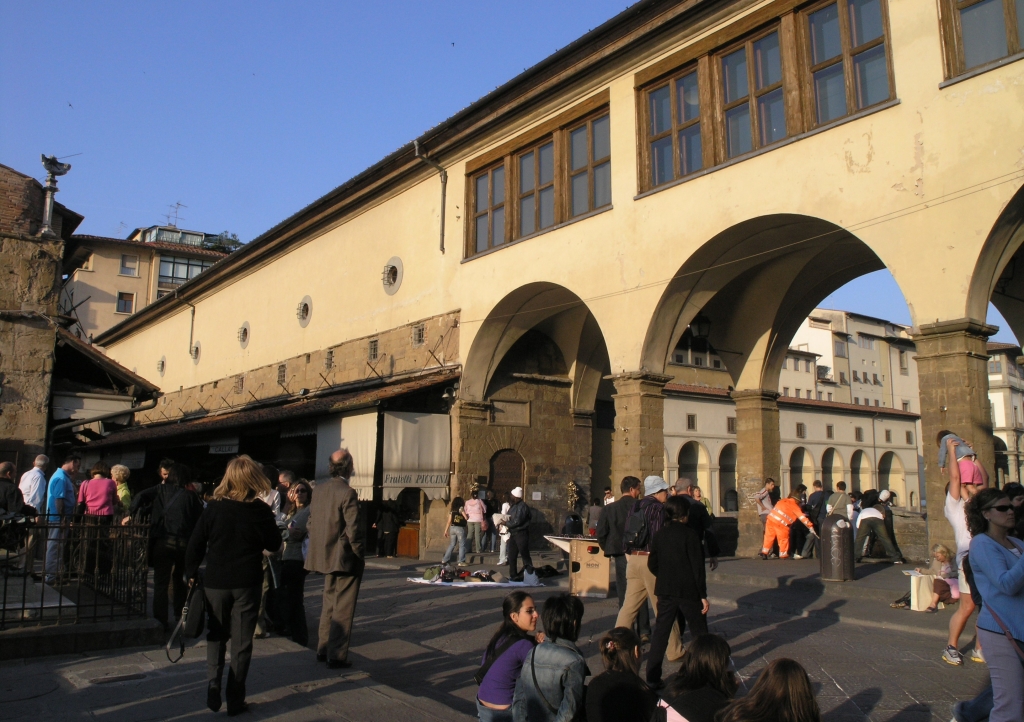
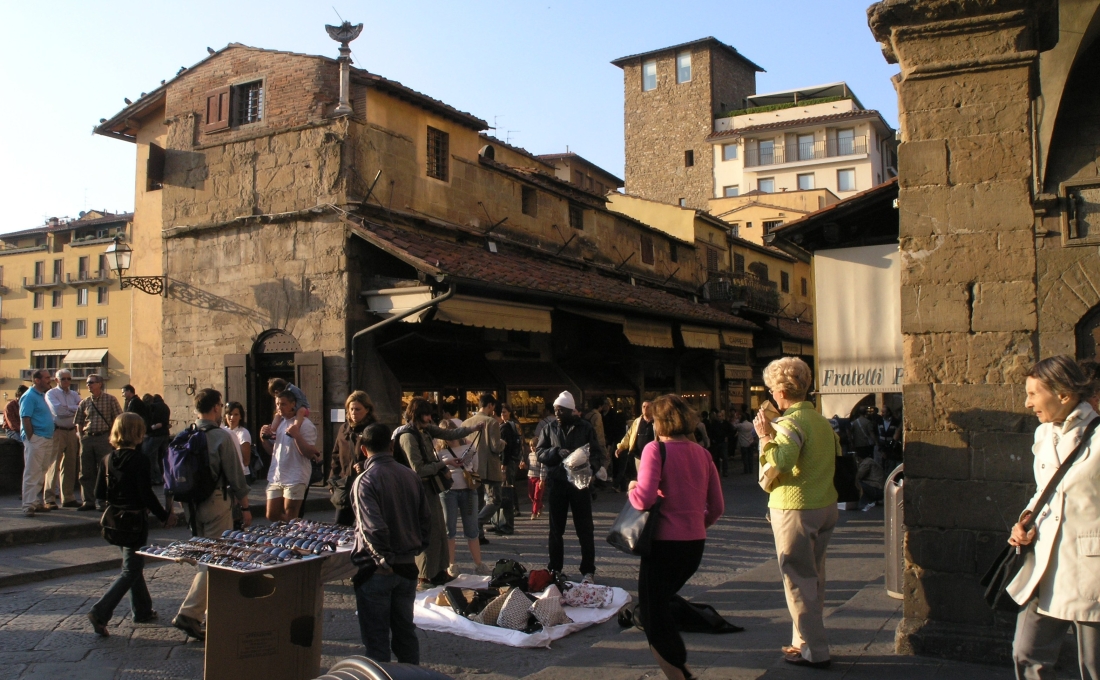

In the middle of the bridge there´s also a statue of one of the Renaissance geniouses of Florence, Benvenuto Cellini: goldsmith, sculptor, artist and musician. The statue was made by Raffaele Romanelli to celebrate the 400th birthday of Cellini in 1900. The railings surrounding him looked like this during our visit but the fashion with lovelocks has later stranded also here: after some years the railings were full of them. The city authorities have removed them and fines people attaching padlocks there (50 €).
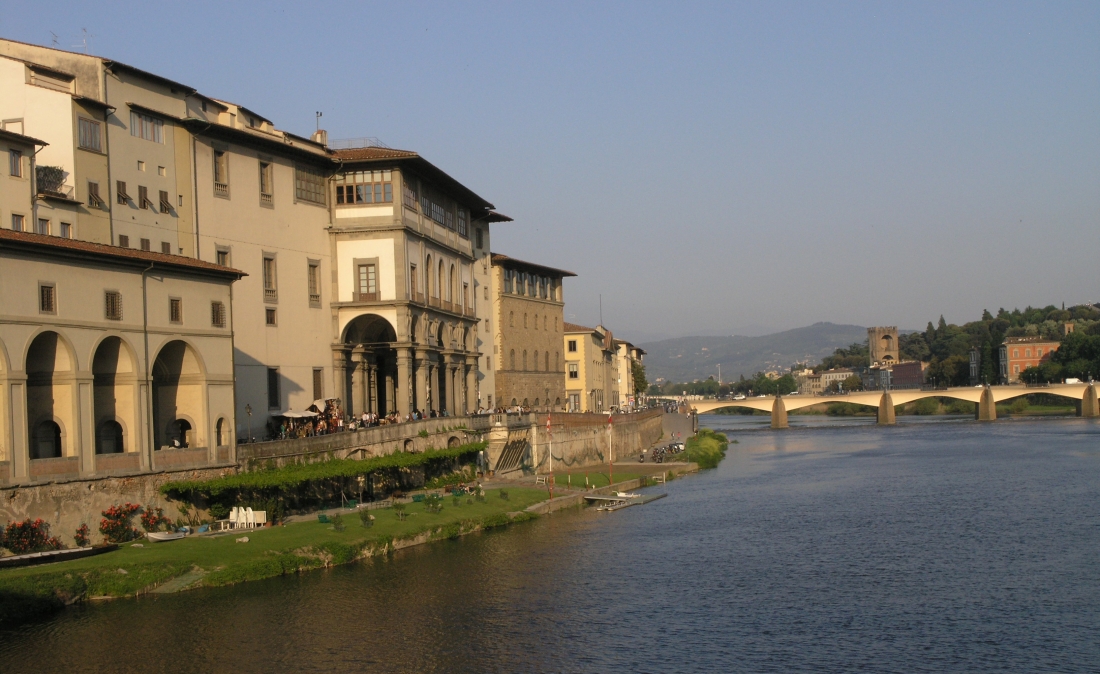
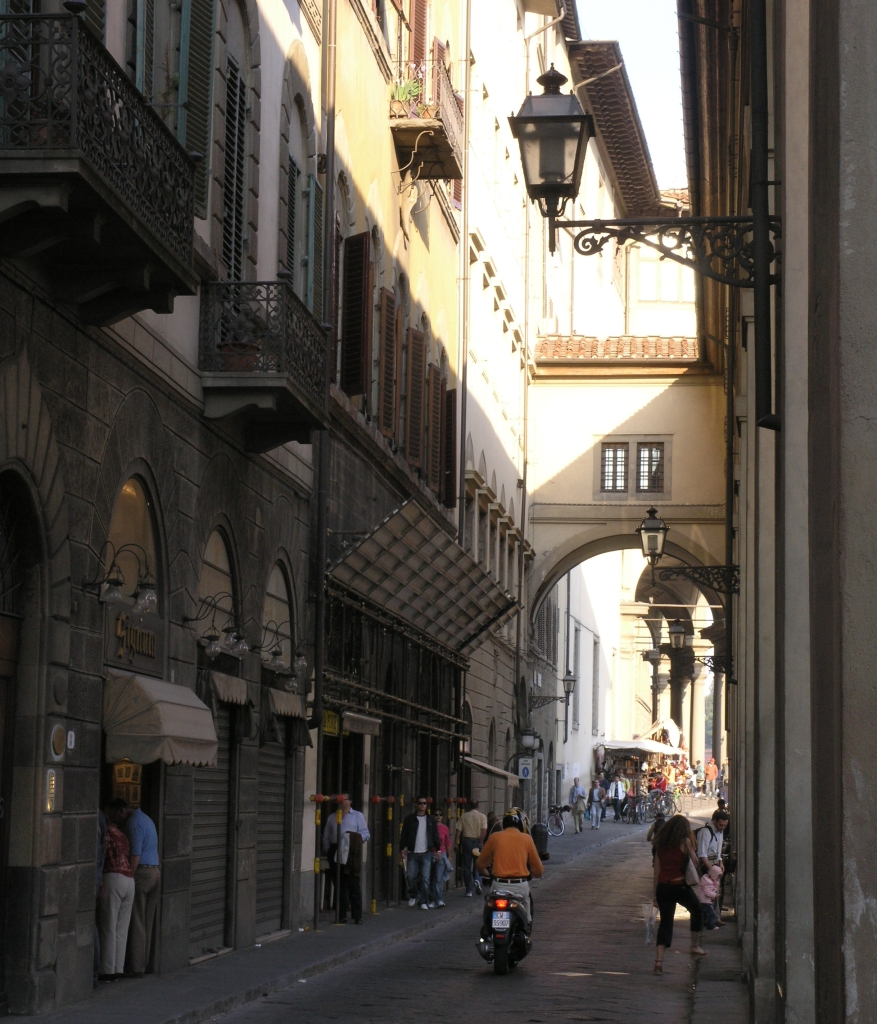
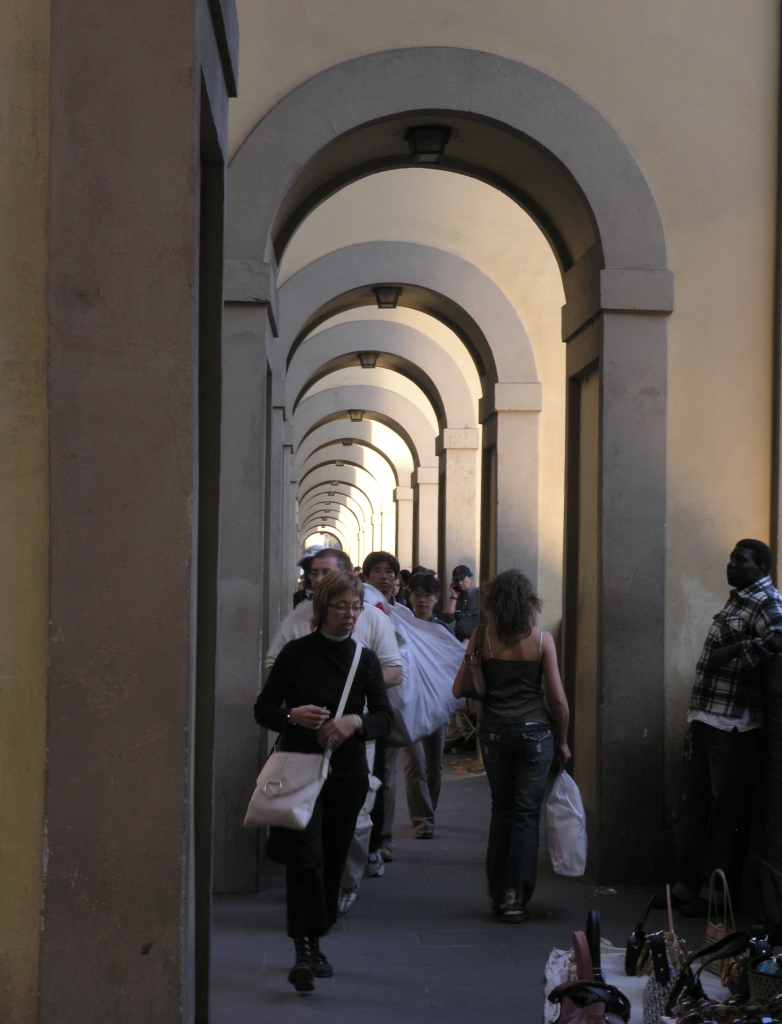
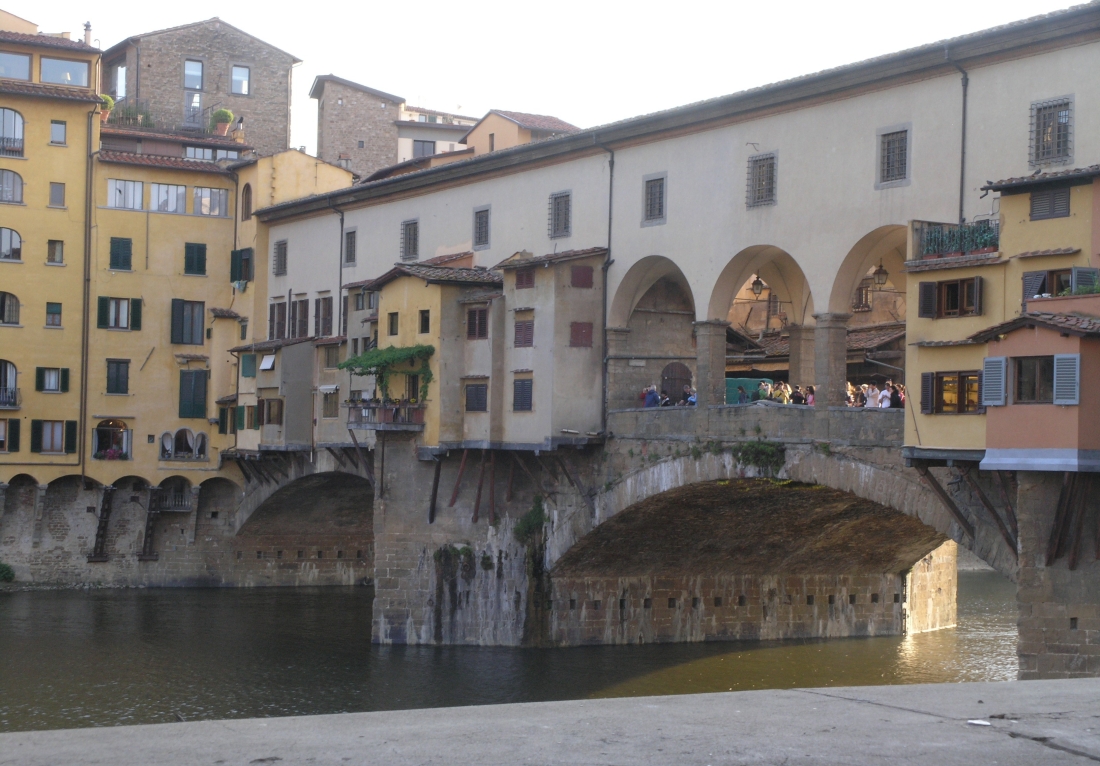
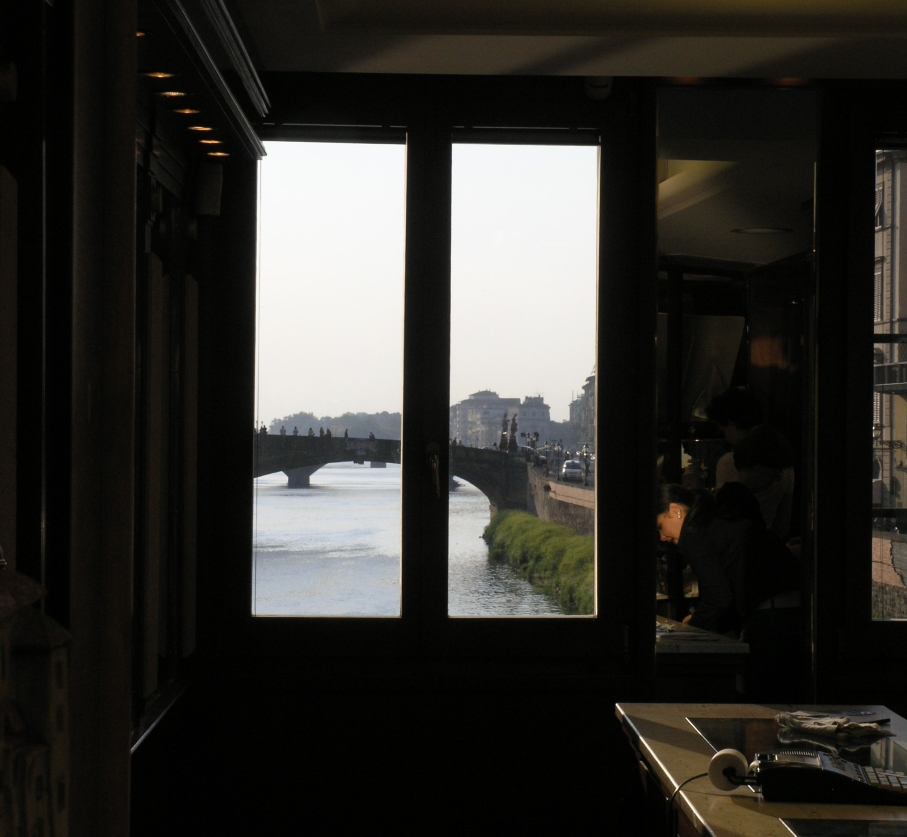
There had been a wooden bridge on the place of Ponte Santa Trinità already 1252. When its predecessor had been taken by the flood 1557, grand duke Cosimo I gave the project for the new structure to Bartolomeo Ammannati, one of the universal geniouses of Renaissance (like Leonardo da Vinci he acted as artist, architect and engineer). The construction work was executed 1567-71. It is believed that also the great Michelangelo contributed strongly to the design but he died 1564 and thus Ammannati had to complete the plans. He had first difficulties to get the authorities to accept this brave design. The arches were namely even shallower than in P. Vecchio: the span-to-rise ratio was 7:1 as the customary value was 3:1 those days. Like with Ponte Vecchio, in his design the middle span, 32 m, is 3 m wider than the two others, mainly for the looks but also to allow easier navigation in the river. He applied for the first time in the world the so called basket arch (or: elliptical arch) which had come up in the writings of contemporary theorists of architecture. The name comes from the shape of the section of a basket placed upside down. In constructing this arch with changing radiuses Ammannati used six different center points altogether. His works represent artistically a transition from Renaissance towards Baroque which is here seen e.g. in the pompous plaques in the arch tops.
The pylons of the bridge are shaped like a ship’s bow, a shape that lessens the impact of tree trunks swept along by floods. Florentian residents seem to have found the “ship decks” are optimal places to lounge and enjoy the riverscape in sunshine…
The retreating German army destroyed the bridge in 1944. It was rebuilt 1955-58 by architect Riccardo Gizdulich and engineer Emilio Brizzi following faithfully the original designs of Ammannati; it took a lot of pondering especially to get the arches done right. Even the original stones were dredged from the river. The four decorative statues, which had been positioned on each corner of the bridge, were also recovered from the Arno but were all badly damaged. The statues represented the four seasons.They were original commissioned to mark the marriage between Cosimo II and Maria Magdalena of Austria in 1608.
The statues in the north end of the bridge: Summer (left) and Spring
And then it was time to walk back to the car and leave Florence… but here´s our last glimpse from the steps of San Miniato al Monte towards the historical centre: the tower top of Palazzo Vecchio against the evening sky (in front of this palace there stands the famous statue of David – or a copy of it – the valuable original is to be seen in Accademia di belle arti di Firenze):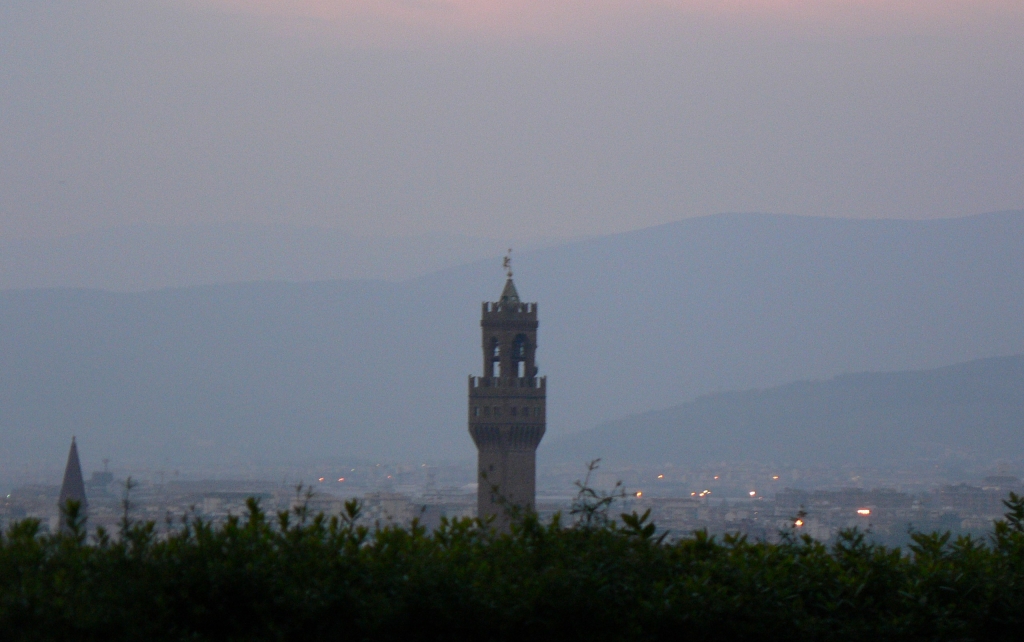




Got you! Interesting, thanks for letting me know
LikeLike
Ponte Vecchio is remarkable for the low arch rise, but is not the first segmental arch bridge in Europe. The Romans build segmental arches in Spain e.g. at Alconetar (https://en.wikipedia.org/wiki/Alcon%C3%A9tar_Bridge). And Kildwick Bridge in England (https://historicengland.org.uk/services-skills/education/educational-images/kildwick-bridge-kildwick-7213) was built around 1305. Great blog, by the way!
LikeLike
Thank you for the correction! I made an update to the blog; I didn´t change the original text otherwise than marking also the word “low” in “first low segmental arches” red – but I added an amendment based on your comment. Namely, I was believing that the Romans built only semi-circular arches – it´s told so “everywhere” but – now I know better…
LikeLike